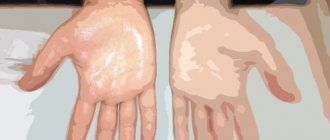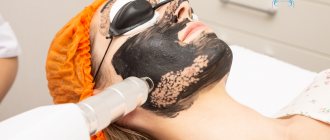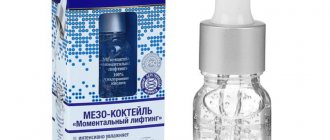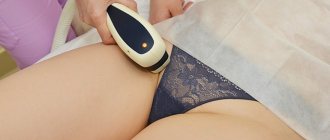Expert review
- Efficiency
- Price
- Safety
- Duration of action
- Recovery period
General opinion
Iontophoresis is a very effective method for combating hyperhidrosis in almost all problem areas. Unfortunately, it may not work, so before purchasing it is advisable to try this method in any cosmetology center that uses a modern analogue. Otherwise, you risk losing a fairly decent amount of money, because... its cost is quite high.
But if it suits you, then you will forever forget about antiperspirants with aluminum and other products that you often used to combat excessive sweating.
Flaws:
- Cost of the device;
- Doesn't start working right away;
- The procedures are quite time-consuming.
Advantages:
- Effectively copes with the main task;
- Safe;
- Compact.
4.2
Increased sweating leads to the fact that the skin in conditions of constant humidity becomes macerated and becomes infected with bacteria and fungi. And also, importantly, it interferes with normal social interaction and professional fulfillment.
This article focuses on one of the most popular treatment options that is safe, simple and effective.
Iontophoresis for hyperhidrosis has been used for decades. This method is based on the gradual destruction of the ion channels of the sweat glands under the influence of electric current.
The reaction occurs not in the glands themselves, but at their nerve endings, due to which there is a reduction in sweat secretion.
This method is effective and highly effective, regardless of the cause of excessive sweating!
It is worth noting that iontophoresis is indicated in cases of local hyperhidrosis:
- palms;
- stop;
- armpits;
- heads;
- faces.
It is not used for generalized sweating.
Galvanization is used independently or as a step in complex conservative treatment and in terms of effectiveness can easily compete with therapy with botulinum toxin preparations
Iontophoresis for hyperhidrosis - history of the method
When performing iontophoresis, the patient immerses his hands and feet in baths of water.
Iontophoresis (also called galvanization) as a treatment method has a very interesting history. At the beginning of the twentieth century, when scientists just began to use electric current to treat various diseases, they tried to treat mainly muscles and joints. This direction developed especially rapidly in Germany.
Electrodes were lowered into a bath of water in which the drugs were dissolved, a weak current ran through them, and in this simple way the active substance was delivered to the diseased organ (for example, to a joint).
However, as pharmacology developed, more and more drugs appeared that did not require delivery using electric current. And the need for iontophoresis has noticeably decreased. But, most interestingly, a group of scientists noticed such a phenomenon - when treating any disease with electric current, an unusual effect appeared - sweating on the palms and soles decreased significantly. That is, the current somehow affected the sweat glands.
The equipment in those days was expensive and complex, so the method was not widespread. But during the twentieth century, doctors did not give up attempts to learn how to treat hyperhidrosis using iontophoresis. Experiments were carried out, medicines or various salts were added to baths of water, and galvanization devices were improved.
Theories of the effect of iontophoresis on sweat glands
And an unusual thing turned out - simple tap water under the influence of current had exactly the same effect on the palms and feet as medicinal solutions. And this did not depend on the cause of hyperhidrosis. The essence of the method today is explained as follows: the sweat glands of the human body react to sodium, potassium and, mainly, chlorine ions. After this discovery, iontophoresis for hyperhidrosis began to be used in Germany, the USA and Japan, and by the end of the 60s it had firmly gained its place among other treatment methods. The mechanism of action on the sweat glands has not yet been precisely elucidated.
There are two theories that try to explain the therapeutic effect: the first states that iontophoresis reduces the secretion of sweat directly from the sweat cells. According to another theory, iontophoresis causes blockage of the tubules through which sweat exits to the surface of the skin. Be that as it may, iontophoresis affects the palms and soles, and this leads to a decrease in hyperhidrosis. The main condition is that the patient must strictly follow the instructions received from the attending physician and, of course, the instructions for the device (if treatment occurs at home). In particular, if there are wounds or cuts on the palms or soles, they must first be lubricated with Vaseline so that electricity does not affect them.
Briefly about the essence of the method, its advantages and disadvantages
Iontophoresis is a physiotherapeutic procedure that involves the effect of a constant galvanic current of low voltage and low force on the human body (or rather, on certain parts of it).
Water are good conductors of current. Therefore, the problem area of the body should be wet. To do this, the electrodes are placed in baths of water, and when, for example, palms are dipped into it, the circuit is closed.
The mechanism of the therapeutic effect of low-intensity current for hyperhidrosis is actually not fully understood. The main theories are as follows:
- under its influence, the functions of the sweat glands are disrupted and their secretion decreases;
- During iontophoresis, epidermal cells die and block the ducts of the sweat glands.
Be that as it may, the method works and confirms its effectiveness by numerous scientific studies in many countries around the world. Based on the results of experiments, as well as in the process of surveying patients undergoing treatment in clinics, it is known that it helps in 85-95% of cases.
Iontophoresis has clear advantages:
- does not have a negative effect on the skin at the site of exposure;
- does not negatively affect the functioning of other organs and systems;
- is a non-invasive method of therapy;
- has virtually no side effects.
I would also like to say about the disadvantages of therapy:
- the need for regular re-treatment (at least for some time);
- relatively high cost of one procedure;
- the method does not affect the cause of hyperhidrosis, but only fights its manifestations;
- applicable only in cases of local sweating;
- sometimes compensatory hyperhidrosis occurs in other parts of the body.
Iontophoresis procedure
Iontophoresis apparatus
When performing iontophoresis, the patient immerses his hands and feet in baths of water. A weak electric current is passed through the water, which has a healing effect. Session duration is 30 minutes. It takes 5 to 10 daily sessions (or every other day) for a lasting reduction in sweating. The number of sessions and current strength are selected strictly individually for each patient; this is usually determined by a physiotherapist or dermatologist.
The procedure is considered generally safe and the patient is not exposed to any risk. Still, the patient needs to listen to his feelings, and if iontophoresis leads to pain, the procedure should be stopped immediately or the current level reduced (too much current can cause pain).
A slight tingling sensation is considered normal, the patient is explained that during the procedure some sensations are possible, in particular tingling, but there is no need to be afraid of this.
It is considered ideal when the device contains separate special baths for the palms and feet. In this case, both the feet and palms are completely covered with liquid and the treatment process takes place in full. In addition, such baths are easily treated with disinfectant solutions, and several people can use them without the risk of becoming infected, for example, with a fungal disease.
Portable devices for home use cannot be treated as thoroughly, so it is better not to use them among several people. Typically, trial sessions of iontophoresis treatment are carried out in the clinic, and if a positive effect is achieved, the patient is recommended to purchase a portable device and continue treatment at home.
The fact is that after normal sweating is achieved, the effect does not last too long, and it will be necessary to carry out repeated sessions (this is called a course of maintenance procedures) approximately once a month.
Of course, it can also be done in a clinic. Ideally, the course should be repeated every time the symptoms of hyperhidrosis reappear.
Treatment of armpit sweating with iontophoresis
Hyperhidrosis in the axillary area can also be treated with iontophoresis, but access to this area is not as convenient as, say, the palms or soles. Despite this, special electrodes have long been invented that are applied directly to the armpit area. It is not very convenient to hold the electrodes with your hands during the session, but those who adapt and tolerate these inconveniences are very satisfied with the treatment. Most often, these are patients who are already undergoing treatment for hyperhidrosis of the palms and feet and have become convinced of its effectiveness. But still, for hyperhidrosis of the axillary region, iontophoresis is not the main method; botulinum toxin injections or antiperspirants are used much more often.
Operating principle of iontophoresis
Iontophoresis is based on the principle of positively and negatively charged ions. Positively charged ions promote deep penetration of acidic compounds, improve microcirculation, relieve tension and muscle spasms, normalize the activity of the sebaceous glands, reduce the number of rashes and narrow pores.
Negatively charged electrodes help penetrate the epidermis of alkaline compounds, which improve skin quality, open pores, and increase cell excitability. As a result of the action of differently discharged ions, internal stimulation, lymphatic drainage, skin cleansing, exfoliation of dead cells, activation of metabolic processes, improved integument regeneration, and removal of waste and toxins occur.
Like other procedures, iontophoresis in cosmetology has its advantages and disadvantages.
Among the advantages are high efficiency, non-invasiveness, absence of a rehabilitation period, painlessness, and a wide range of effects. The disadvantages of iontophoresis include a fairly large number of contraindications and a fairly high cost of one session. Read more
Iontophoresis - contraindications
Electric current treatment certainly gives good results for hyperhidrosis, but there are a number of diseases for which iontophoresis is contraindicated. This primarily concerns cancer patients. Even if the tumor is benign, it cannot be treated with galvanic current. Such treatment methods are not recommended for pregnant women. And, of course, if there are skin diseases or serious damage to the skin, this is also a contraindication.
If the patient’s body contains metal implants (artificial joints, metal structures after osteosynthesis operations) or pacemakers, iontophoresis is contraindicated. Hyperhidrosis cannot be treated with electric shock in case of hypertrichosis (a disease in which there is increased growth of body hair). When the doctor is convinced that there are no contraindications, a course of treatment is prescribed.
A huge number of patients have already been convinced of its effectiveness, safety and economic accessibility. Therefore, iontophoresis is widely used for hyperhidrosis, and doctors often begin treatment with it. And only in the absence of a positive result, they resort to more traumatic methods - Botox injections and surgery.
The head of the Center for the Treatment of Hyperhidrosis, Kuzmichev V.A., tells more about the treatment of sweating of the palms using iontophoresis:
Appliances for home use
In order to successfully combat hyperhidrosis, it is absolutely not necessary to visit physiotherapy rooms. Portable, convenient devices designed for home use can be purchased at medical equipment stores.
Here are the most popular ones:
- iontophoresis kit SwiSto 3;
- Electro Antiperspirant;
- Medisun GS 10;
- Drionic;
- Idromed 5 PS;
- Idromed 5 GS
- Hidrex PSP1000.
Instructions for using iontophoresis devices generally do not differ from each other. Although each manufacturer may have some nuances.
The price of a device for home iontophoresis is about 25,000 - 55,000 rubles, and by purchasing it, you can:
- receive quality treatment;
- get the opportunity to do procedures at a time convenient for you and with the required frequency;
- It's really good to save money.
Who is iontophoresis contraindicated for?
Short-term exposure to low-intensity direct galvanic current on the body does not cause concern, provided that the person does not have the following health problems:
- tumors (not only malignant, but also benign);
- serious diseases of the cardiovascular system;
- thrombophlebitis;
- polyneuropathy;
- trauma, skin damage in the affected area, dermatological pathology;
- acute infections;
- hypertrichosis (increased body hair growth);
- epilepsy and epileptiform syndrome;
- local sensitivity disorders;
- individual intolerance to electric current;
- hyperthermia.
It is also not recommended to use this method when:
- pregnancy;
- presence of a pacemaker;
- the presence in the body of implants made entirely or partially of metal;
- children.
During electrical exposure to an area with hyperhidrosis, there should be no pain. The maximum you can feel is a slight tingling sensation.
If you have very sensitive skin and irritation quickly appears, after the procedure, treat it with Vaseline, baby cream or hydrocortisone ointment.
If pigmentation appears on the skin in the affected area, it is recommended to stop the procedure!









